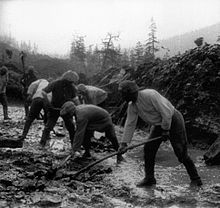- Sevvostlag
-
Sevvostlag (Russian: Северо-восточные исправительно-трудовые лагеря, Севвостлаг, СВИТЛ, North-Eastern Corrective Labor Camps) was a system of forced labor camps set up to satisfy the workforce requirements of the Dalstroy construction trust in the Kolyma region in April 1932. Organizationally being part of Dalstroy and under the management of the Labor and Defence Council of Sovnarkom, these camps were formally subordinated to OGPU later the NKVD directorate of the Far Eastern Krai. On March 4, 1938 Sevvostlag was resubordinated to the NKVD GULAG. In 1942 it was resubrdinated back to Dalstroy. In 1949 it was renamed to the Directorate of Dalstroy Corrective Labor Camps (Управление исправительно-трудовых лагерей Дальстроя). In 1953, after the death of Joseph Stalin, with the reform of the Soviet penal system, it was again resubordinated to Gulag and later reformed into the Directorate of Far Eastern Corrective Labor Camps Управление Северо-восточных исправительно-трудовых лагерей, УСВИТЛ (USVITL).
The inmates served on all Dalstroy projects, the major ones being gold mining and road construction, including the infamous Kolyma Highway.
Structure and prisoners
Sevvostlag was the sole administration for the whole system of the forced labor of Dalstroy. The numerous labor camps usually mentioned for Kolyma and Dalstroy were formally referred to as subcamps ("camp subsivisions", лагерные подразделения) attached (but not subordinated) to the corresponding production units. Until the 1950s the only exceptions were camps on the periphery of Kolyma, which while servicing Dalstroy, were either detached from or attached to Sevostlag at various times. [1]
Prisoners at the Sevvostlag[2] Year Number Year Number 1932 11,100 1943 99,843 1934 29,659 1944 76,388 1935 36,313 1945 87,335 1936 48,740 1946 69,389 1937 70,414 1947 79,613 1938 90,741 1948 106,893 1939 138,170 1949 108,685 1940 190,309 1950 131,317 1941 179,041 1951 157,001 1942 147,976 1952 170,557 Figures for 1 January for each year.
Figure for 1932 for DecemberFrom 1945-1949 there was a subcamp for Japanese prisoners of war in Magadan, which held 3,479 prisoners by January 1, 1949.[1]
Notable inmates include the poet Osip Mandelshtam and Varlam Shalamov, author of the Kolyma Tales.
Management and headquarters
The management was initially headquartered in the Srednikan settlement (now Ust-Srednekan, Magadan Oblast). It was moved to the Nagayev Bay (Бухта Нагаева, now Magadan Oblast), and eventually to Magadan.
Key individuals included:
- Rodion Vaskov (Родион И. Васьков) – (11.03.32 - 09.28.34)
- Ivan Filippov (Иван Г. Филиппов) – captain of state security (09.28.34 – 12.21.37)
- Stepan Garanin (Степан Н. Гаранин) – (12.21.37 – 09.27.38)
- A. Vishnevetsky (А.А. Вишневецкий) – captain of state security (02.16.40 – 02.19.41)
- Yevekl Drabkin (Евекль Иделевич Драбкин) – colonel of state security (05.19.41 – 03.13.45)
- N. Titov (Н.Ф. Титов) – Major General (03.13.45 – 07.27.48)
- A. Derevianko (А.А. Деревянко) – Major General (07.27.48 – 05.03.51)
Notes
- Specific
- ^ a b History of Dalstroy (Russian)
- ^ СВИТЛ, from the reference book "The System of Corrective Labor Camps in the USSR" (Russian)
- General
- Дальстрой (Russian)
- Золотодобыча на Колыме (Russian)
Categories:
Wikimedia Foundation. 2010.

